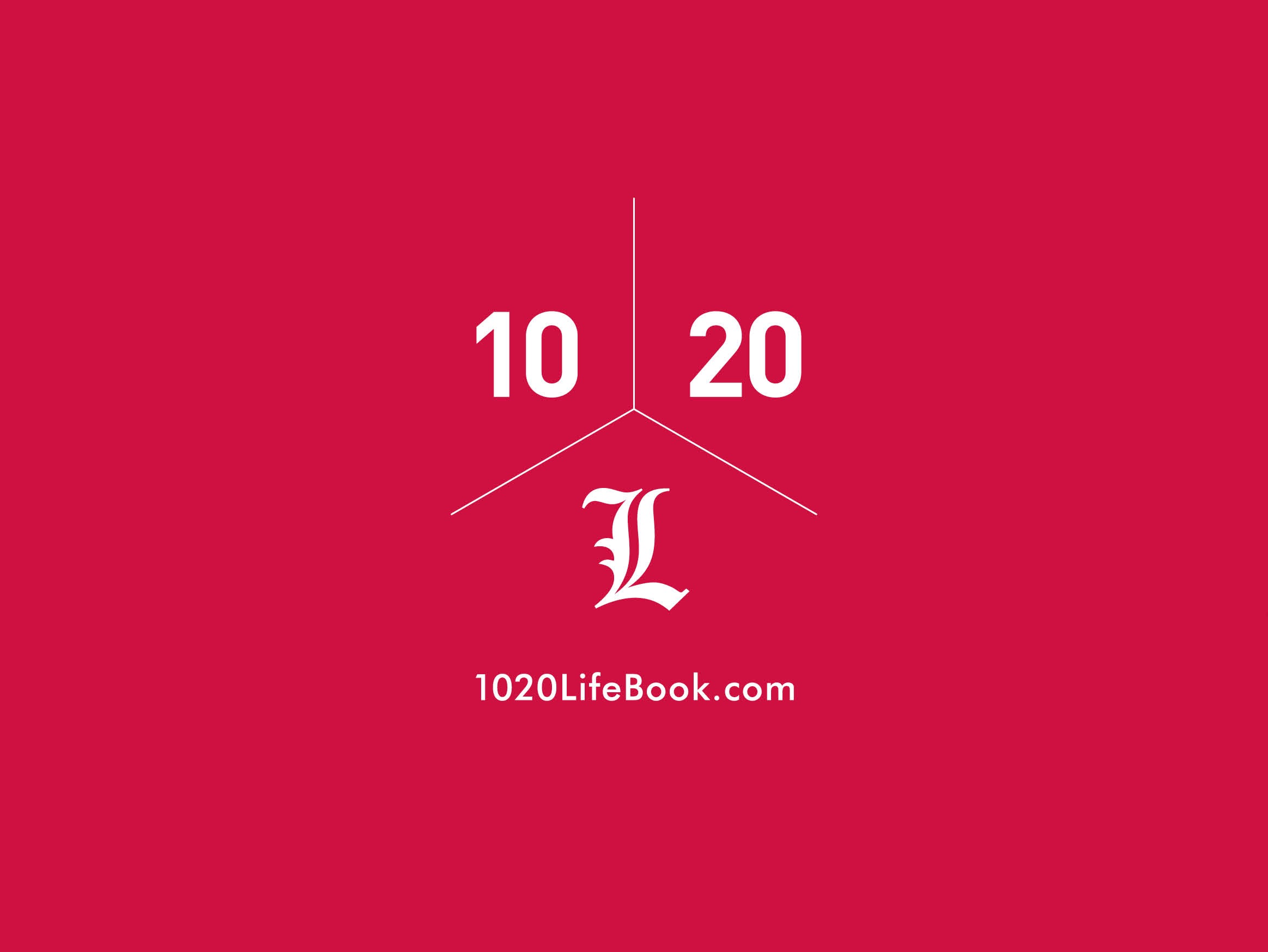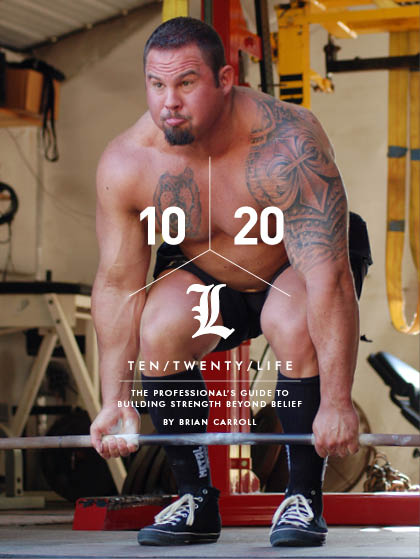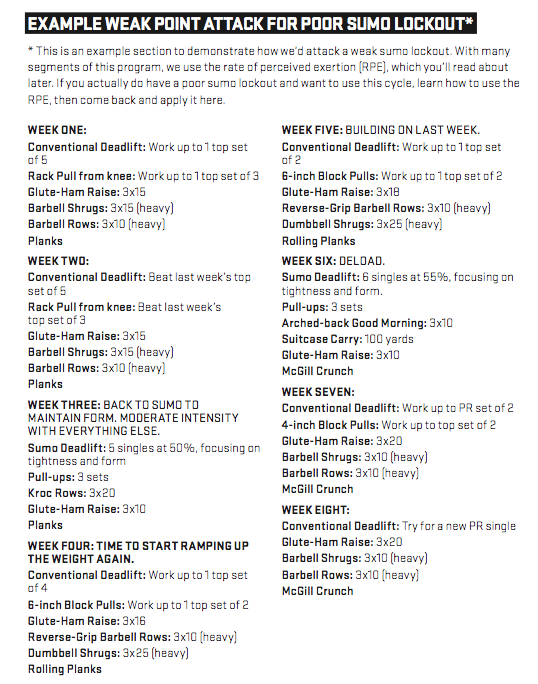
16 Apr 10/20/Life: The Professional’s Guide to Getting Strong
By Brian Carroll
I’m not a “fitness personality.” I don’t want anything to do with that crap. I want to make people stronger and get my information out there for people to learn the right way to train, but I’m not interested in becoming some kind of icon that everybody blindly follows. I think that’s weird, and I’m trying to do the exact opposite.
Having a “badass” attitude has nothing to do with results. I created 10/20/Life because I wanted to show people that getting stronger is what’s important in life—and not creating some kind of cool guy persona that everyone can try to be like. That’s not me.
I don’t tell. I show, and I’ve been doing that on the big stage for a dozen years. Here’s how.
How This Came About
I’ve set multiple world records in three different classes in powerlifting, including totaling significantly more in the 220 pound class than some strength training icons have at 275 and above. My best lifts include an 825-pound bench press, an 800-pound deadlift, and a then-world-record 1185-pound squat.
Early in 2013, I found out I had a broken back. Literally. My doctors diagnosed me with multiple serious back issues, and I was in severe pain and discomfort with everything I did. On a whim, I took a shot at contacting Dr. Stuart McGill, the world’s foremost authority on back health. I traveled from Florida to Canada twice, he showed me how to rehabilitate my back, and less than ten months later, I was squatting 1100 pounds again.
My Philosophy
The fastest, easiest, most effective way to get stronger is through the big lifts—the squat, bench press, and deadlift. And the fastest, easiest, most effective way to improve your performance in these lifts is to analyze your weak points and custom-design your own programming that addresses them and gets you stronger.
Weak Points
When you fail in one of the big lifts, that’s a weak point. If you can’t lock out your bench press, you have weak triceps. If you’re pitching forward and getting stapled when you squat, it’s probably a hamstring or lower back issue. If you’re constantly training heavy, and ignoring these deficiencies, you’re not going to get any stronger.
Customized Assistance Work
You have to address your weak points through your assistance work. If you find out you have weak triceps, or weak hamstrings, you need to pay special attention to these muscle groups in your training—and not just follow some cookie-cutter template laid out for you by your guru.
Rate of Perceived Exertion (RPE): Your Personal Coach
You’ve been hearing a lot recently about auto-regulation and products like Joel Jamieson’s BioForce HRV. The idea is to assess your state of readiness for the day, and to do just enough training to get the job done—no more, and no less. Instead of sticking to a fixed percentage for a particular day—and possibly overtraining or getting injured—RPE training allows you to train within the appropriate percentages for that day. It’s really the best possible way to train, and the fastest way to get strong.
Offseason and In-Season Training
Contrary to popular belief, it’s impossible to stay strong 365 days per year. Take a lesson from professional athletes and schedule your training accordingly, with offseason and in-season work. If you’re constantly in-season, when are you planning on addressing your weak points? If you’re always “on,” you’re going to come to a breaking point where you’ll either get injured or quit. Give yourself some highs and lows, and some downtime, and be strong when it counts.
Dr. McGill’s Material: It Works
Why would you possibly want to stretch, foam roll, and get loose before putting a heavy load on your back? That’s just stupid, and it’s a recipe for disaster. Instead, you’d be much better off learning how to stiffen your core so you can handle these loads and generate power and explosiveness. That’s how you get strong.
10/20/Life: The System
With 10/20/Life, you’re going to train either three or four days per week. On the four-day plan, you’re focusing on one big lift—squat, bench press, or deadlift—per day, along with a fourth day of strict assistance work. On the three-day “combo” plan, you’ll combine days.
The plan is an easy five-step process.
1. Choose your schedule.
2. Determine your weak points in the main lifts.
3. Use the Weak Point and Assistance Exercise indexes to custom design your own program.
4. Follow the warm-up protocol listed.
5. Determine your level of readiness, then train according to the system’s RPE plan for that day.
6. Train hard for two weeks, then deload (do an “easy day”) every third week.
Here’s an actual screenshot from the book to illustrate how a specifically tailored eight-week cycle would look:
Again, one of the most important features of 10/20/Life is its Weak Point and Assistance Work indexes. These will show you how to coach and train yourself by teaching you to analyze your own lifts to determine where you’re weak.
Once you’ve done that, all you have to do is plug and play, and you’re given multiple options for getting the job done. Instead of saying, “Hey, you have weak hamstrings. Do some glute-ham raises,” the idea is to give you multiple options for solving the same problem.
Not everyone is going to get the same results from the same exercise. Some people may be able to fix their lockout strength in the bench by doing dips. For others, this might not work. You have to keep trying different solutions until you come across the one that works specifically for you and your purposes.
Addressing the Critics
So far, the biggest criticism I’ve heard about 10/20/Life pertains to people who don’t think an equipped powerlifter who uses gear can tell them anything about getting stronger. I’ve written a separate article with a longer response to this critique, but I’ll summarize my main points here.
First off, most of my training is done raw, wearing no gear. The only time I actually put gear on is when I’m getting close to a meet. Other than that, there’s no difference between what I wear to the gym and what you do.
Next, the concept of addressing and improving weak points applies to everyone, no matter who you are or why you train—and you don’t wear powerlifting gear when you’re doing assistance work.
It’s all the same, really, so when you think about it, powerlifters are the best group of people to learn from when it comes to the big lifts. We’ve been refining and perfecting them for decades, and we’ve got this stuff down to a science. Why go anywhere else?
Four More Key Points
1. Customization is the key: The same programs and movements don’t work the same way for everyone, so why would you possibly want to follow some cookie-cutter template that tells you, “Do it this way, or you’ll fail”?
To get stronger and see results, you need to figure out what works for you, and that starts, again, with a comprehensive analysis of your weak points. 10/20/Life will teach you how to coach yourself like a professional.
2. Form and technique are everything: I’ve successfully completed more than thirty squats over 1000 pounds in competition. When you have that much weight on your back, everything counts. If something is even a millimeter off, I’m going to miss the lift, and I’ll probably suffer a debilitating injury.
As a result, I’ve spent decades figuring out how to do these lifts correctly. I’d rather be in the gym training than sitting in a hospital bed, so I’ve done this out of necessity—and the same applies to you no matter how much you’re currently lifting.
3. Stop foam rolling: Out of everything I’ve said in 10/20/Life, this is the one that’s made the most waves, but I’ll stand by this statement every day of the week. Dr. McGill said it, I lived it, and it works. Again, you don’t want to get loose before a big lift. You want to stay tight and generate all the power you can.
4. Be a professional in the gym: Look at the guys who constantly and consistently win in sports: Michael Jordan. Tiger Woods (before his ex-wife took a golf club to his truck). Derek Jeter. Sidney Crosby. There are exceptions, but when you’re an athlete, your goal is strictly winning—not creating an image or trying to be the coolest guy in your gym or in your little Facebook circle. You get to be considered “cool” with results, not by talking about it or forcing the issue.
The number one theme in 10/20/Life? Stop acting like a douche, keep your mouth shut, train the right way, and win.
How to Make 10/20/Life Work For You
- Don’t overtrain. Stick to the two-weeks-on, one-week-deload plan, along with the RPE recommendations, and make sure you’re fresh and ready to go for every session.
- Be honest with yourself about your weak points. You may like certain assistance exercises because you’re good at them and you can impress people, but they may not be the ones that’ll help you. Do an honest, legitimate assessment of where you’re weak, then use the Weak Points and Assistance Exercise indexes to truly customize your workouts.
- Understand that this isn’t an eight or sixteen week program. It’s a system, meaning it’s a customizable way you can train for the next twenty years or more. Stay consistent, keep reassessing your weak points and trying new assistance work, and you’ll get really, really strong and stay that way.
- Learn the difference between percentage training and the RPE system, and use it. You’ll progress a lot faster when you get used to training with the weights you’re capable of lifting on that particular day. This may seem confusing at first, but you’ll get used to it after a couple of workouts, and you’ll never want to go back to cookie-cutter percentages again.
- Use the warm-up and core stiffening exercises I’ll teach you—moves like bird dogs, stir the pot, and McGill crunches. Along with some real-world advice on how to get and maintain a healthy back, this is the stuff that took me from barely being able to get in and out of my car to squatting 1100 pounds again in less than a year.
Get The 10/20/Life Ebook HERE!
Brian Carroll
Latest posts by Brian Carroll (see all)
- Quick Rant: Core Exercises - July 26, 2024
- Physical Therapy Fails for Back Pain - July 25, 2024
- Quick Rant: Physical Therapists - July 19, 2024







Sorry, the comment form is closed at this time.